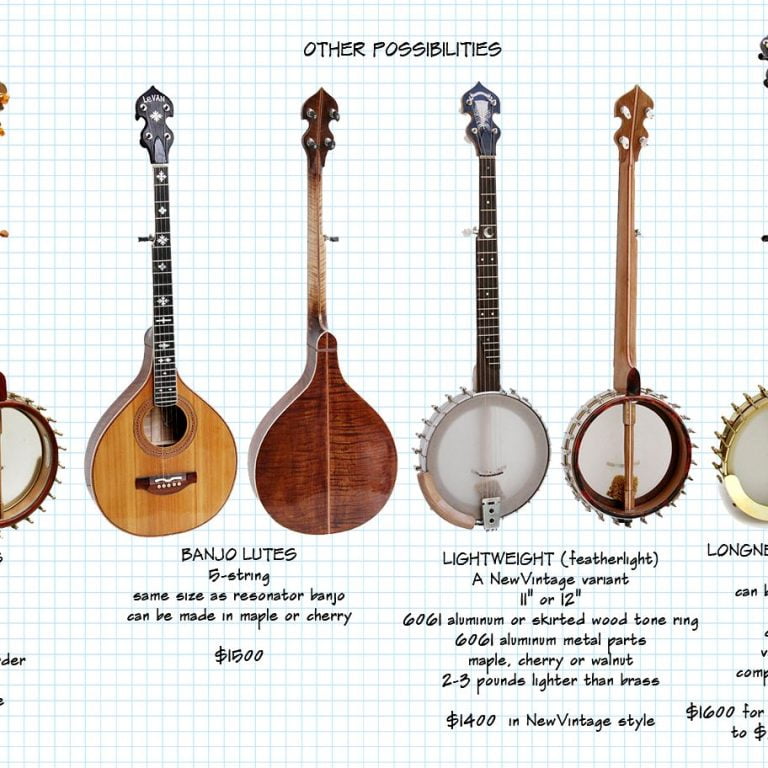Four string banjos tuning are commonly tuned to the open G tuning (G-D-G-B), C tuning (D-G-B-D), or D tuning (A-D-F#-A). Each tuning offers a different sound and can be chosen based on the music genre or personal preference.
The open G tuning is popular in bluegrass and folk music, providing a bright and punchy sound. The C tuning is great for playing in higher keys and is popular in jazz and ragtime. The D tuning offers a mellower sound and is common in traditional Irish music.
Additionally, the Chicago tuning (D-G-B-E) is also used for four string banjos, similar to the top four strings of the guitar, making it easier for guitarists to transition to the banjo.

Credit: m.youtube.com
The Basics Of 4 String Banjo Tunings
The History Of 4 String Banjo Tunings
4 String banjo tunings have a rich history that dates back to the early 20th century. Originally, 4 string banjos were tuned to a variety of tunings, including C tuning, D tuning, and G tuning. However, the most popular and widely used tuning for the 4 string banjo is the C tuning, which consists of the notes G-C-E-A. This tuning is commonly referred to as the “standard” or “Chicago” tuning and is the foundation for many traditional banjo songs. Over time, various musicians and artists have experimented with different tunings, leading to the development of alternative tunings that offer unique tonal possibilities.
Key Components Of 4 String Banjo Tunings
When exploring 4 string banjo tunings, it’s essential to understand the key components that make up each tuning. The tuning of a 4 string banjo refers to the specific pitches assigned to each string, determining the overall sound and range of the instrument. The four strings of a banjo are typically tuned to specific notes, with the most common tuning being G-C-E-A. Each string’s pitch can be adjusted to achieve different tunings, allowing musicians to create diverse melodies and harmonies. Additionally, the tension and gauge of the strings play a crucial role in achieving the desired tuning, as they directly impact the overall sound and playability of the instrument.
Understanding Standard G Tuning
Standard G tuning for 4-string banjo involves tuning the strings to G-D-G-B. This tuning offers a bright and resonant sound, preferred in bluegrass and folk music. Understanding this tuning allows players to explore new melodies and chords while enhancing their playing experience.
Importance And Popularity Of Standard G Tuning
Standard G tuning, also known as Irish tuning, is one of the most popular and versatile tunings for 4 string banjos. This tuning is commonly used in traditional Irish and folk music, as well as in some bluegrass and country styles. The popularity of standard G tuning stems from its pleasant, bright sound and the ease with which it can be played in different musical genres. It allows for a rich, full-bodied sound, making it a favorite among banjo players of all skill levels.
How To Tune A 4 String Banjo To Standard G
Tuning a 4 string banjo to standard G requires adjusting each string to the appropriate pitch. Follow these steps to ensure your banjo is tuned correctly:
- Start by tuning the 4th string to a D note.
- Tune the 3rd string to a G note.
- Next, tune the 2nd string to a B note.
- Finally, tune the 1st string to a D note.
Exploring Other Common 4 String Banjo Tunings
When it comes to playing the 4-string banjo, exploring different tunings can open up a world of sonic possibilities. While G tuning is the most common, there are several other tunings that offer unique sounds and applications. In this article, we’ll delve into two common alternative tunings – D tuning and C tuning – and explore their versatility and distinct characteristics.
D Tuning: A Versatile Alternative To Standard G
D tuning, also known as Double C tuning, is a popular alternative to the standard G tuning. In D tuning, the banjo is tuned to the notes D, G, B, and E from low to high. This tuning is particularly favored by folk and traditional banjo players for its rich, deep sound and its adaptability to a wide range of musical styles. By using D tuning, banjoists can create a wider tonal range, making it a versatile choice for both solo and ensemble playing.
C Tuning: Its Unique Sound And Applications In Different Music Genres
Another common 4-string banjo tuning is C tuning. This tuning uses the notes C, G, B, and D from low to high, producing a lower pitch than G tuning. The C tuning offers a unique, mellow sound that lends itself well to various music genres, including blues, jazz, and old-time string band music. Its distinctive tone and resonance make it a sought-after choice for banjo players looking to add depth and richness to their musical arrangements.
Exploring different banjo tunings can provide a fresh perspective on playing the instrument and inspire new musical ideas. Whether you’re seeking a versatile alternative or a unique sound for your banjo playing, D tuning and C tuning offer compelling options beyond the traditional G tuning.
Unconventional 4 String Banjo Tunings
The 4-string banjo is known for its versatility, and one way to expand its sonic possibilities is by exploring unconventional tunings. While standard tunings like GDAE or CGDA offer a familiar platform for banjoists, non-standard tunings open doors to new creative possibilities. In this article, we’ll delve into the realm of unconventional 4-string banjo tunings, with a focus on the distinct characteristics of the open G tuning and a discussion of the pros and cons of non-standard tunings.
Open G Tuning: A Deep Dive Into Its Distinct Characteristics
Open G tuning, sometimes referred to as “Celtic tuning” in traditional music, is a popular non-standard tuning for the 4-string banjo. In open G tuning, the four strings are typically tuned to G3, D4, G4, and B4, creating a rich, resonant sound that is well-suited for folk, blues, and country music.
The unique characteristic of open G tuning lies in its open chord voicings, allowing players to produce full, robust harmonies with minimal effort. The lowered pitch of the fourth string (B4) compared to the standard tuning enhances the banjo’s ability to emulate lower-pitched instruments, bringing a depth and warmth to the overall tonal palette.
Moreover, open G tuning facilitates the exploration of slide techniques and provides a platform for innovative fingerstyle approaches. The ease of playing chords and melodic structures in this tuning makes it an attractive option for both beginner and seasoned banjo players alike.
Discussing The Pros And Cons Of Non-standard Tunings
When considering non-standard tunings for the 4-string banjo, there are several factors to take into account. The following table provides an overview of the pros and cons associated with non-standard tunings:
Pros Cons
Expanded tonal range
Enhanced creative expression
Fresh musical perspectives
Challenge in adapting to new fingerings
Potential confusion when switching between tunings
Restricted access to familiar chord shapes
While non-standard tunings offer creative advantages and the potential for new musical discoveries, they also present challenges in terms of adaptability and continuity across different tuning configurations. Ultimately, the decision to explore unconventional tunings on the 4-string banjo depends on individual preferences and the desire to expand musical horizons.
Tips For Choosing The Right 4 String Banjo Tuning
When it comes to playing the 4-string banjo, the right tuning can significantly impact the sound and playability of the instrument. Whether you are a beginner or an experienced player, selecting the appropriate tuning can enhance your performance and expand your musical repertoire. Below are some essential tips to consider when choosing the right 4-string banjo tuning.
Factors To Consider When Selecting A Tuning
Before settling on a specific tuning for your 4-string banjo, there are several factors to consider. The choice of tuning should align with your musical preferences and the type of music you want to play. Additionally, you should take into account the tension the tuning places on the instrument and its strings. The tuning should also complement your playing style and provide a comfortable and enjoyable experience. Furthermore, considering the availability of instructional resources and the ability to find fitting tablature can streamline your learning process and the mastery of the chosen tuning.
Adapting Tunings To Suit Different Playing Styles And Musical Genres
Adapting tunings to suit different playing styles and musical genres can significantly expand your creative possibilities. Understanding the characteristics of various tunings and how they can be applied to different styles of music is crucial. For example, certain tunings may be better suited for blues or jazz, while others may be more fitting for folk or traditional styles. By experimenting with different tunings and understanding how they complement different genres, you can develop a diverse and adaptable playing style that resonates with a broad range of audiences.
Frequently Asked Questions For 4 String Banjo Tunings
What Are The Standard Tunings For A 4 String Banjo?
The standard tunings for a 4 string banjo are C-G-B-D and D-G-B-E. These tunings are commonly used in traditional and modern banjo music.
How Can I Change The Tuning Of My 4 String Banjo?
To change the tuning of your 4 string banjo, use a tuner to adjust the tension of the strings. Turn the pegs carefully to reach the desired pitch, ensuring the strings are properly stretched and in tune.
What Are The Alternative Tunings For A 4 String Banjo?
Alternative tunings for a 4 string banjo include D-A-D-F#, G-C-G-B, and G-D-G-B. These variations offer versatile options for different musical styles and experimenting with unique sounds.
How Does The Tuning Of A 4 String Banjo Affect Its Sound?
The tuning of a 4 string banjo significantly impacts its sound. Different tunings produce varying tonal qualities, resonance, and harmonies, allowing musicians to create distinct musical arrangements and expressive performances.
Exploring different 4 string banjo tunings can open up a world of musical possibilities. Whether you prefer the traditional standard tuning or want to experiment with alternate tunings, this versatile instrument offers endless creativity. By understanding the various tunings, you can enhance your playing and create unique, captivating music.
To check our more blogs Click Here




